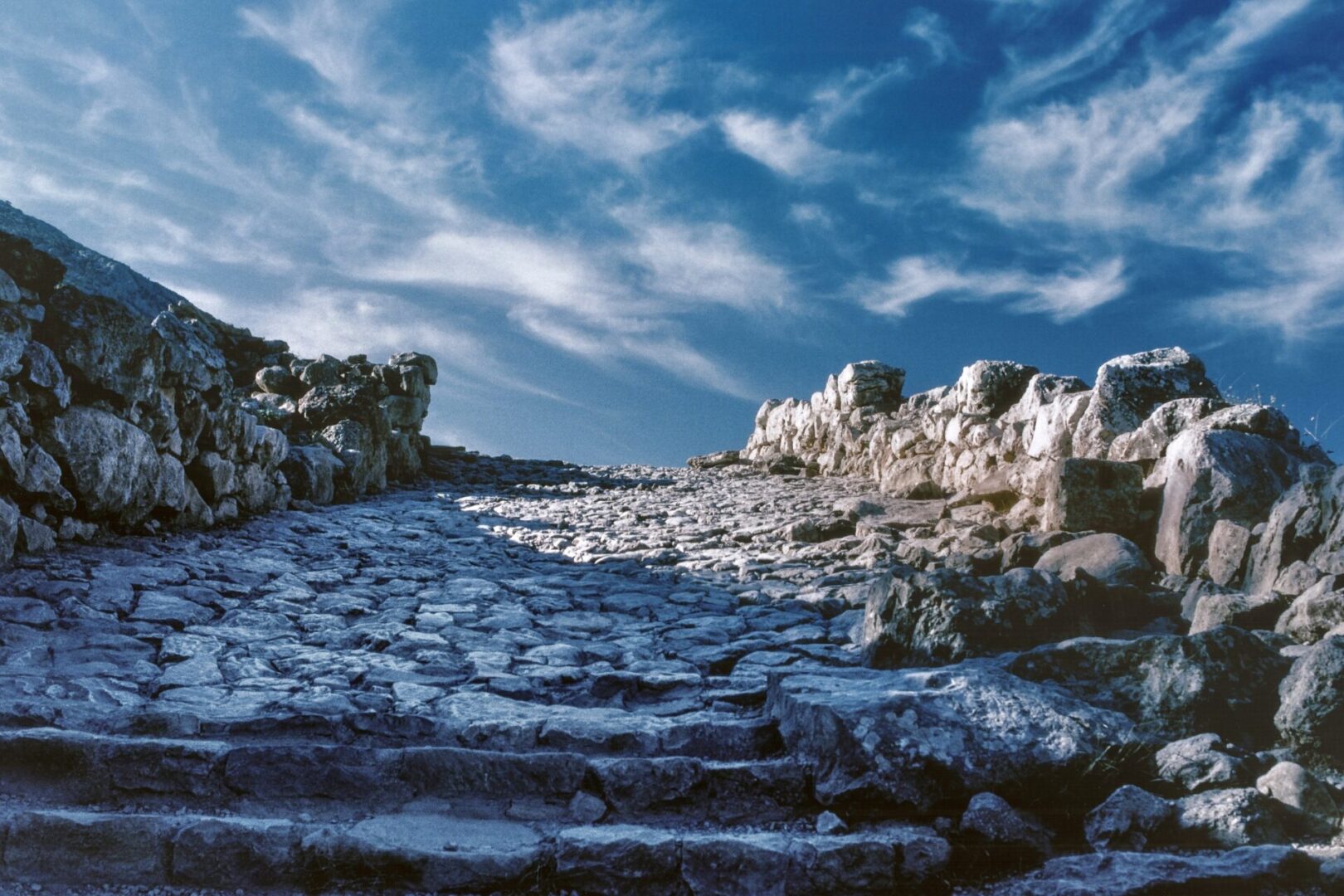
Greek landmarks encompass age upon age of legendary antiquity, ancient history, and contemporary eras.
Mainland Greece and the Greek Islands are a treasure trove of magnificent monuments to history, culture, and nature.
Understandably, this monumental treasure comes with a monumental deluge of visitors to the most popular and most famous landmarks. Particularly in peak season.
So let’s discover together some of the best Greek landmarks off the beaten path. Some are just a little less famous than the major attractions, others are genuine hidden gems.
Ancient ruins, historical sites, natural beauty, rich history, traditional culture, and authentic experiences await you.
Ready? Let’s go!
Table of contents
- Greek Landmarks Off the Beaten Path in Athens, Attica
- Greek Landmarks Off the Beaten Path in Central Macedonia
- Greek Landmarks Off the Beaten Path in Crete
- Greek Landmarks Off the Beaten Path in Eastern Macedonia and Thrace
- Greek Landmarks Off the Beaten Path in Epirus
- Greek Landmarks Off the Beaten Path in the Islands
- Greek Landmarks Off the Beaten Path in Peloponnese
- Greek Landmarks Off the Beaten Path in Thessaly
- Greek Landmarks Off the Beaten Path in Western Macedonia
- Greek Landmarks Off the Beaten Path in Conclusion
- Greek Landmarks Off the Beaten Path Map
- Check Out More Recommendations
- FAQs
Greek Landmarks Off the Beaten Path in Athens, Attica
Odeon of Herodes Atticus
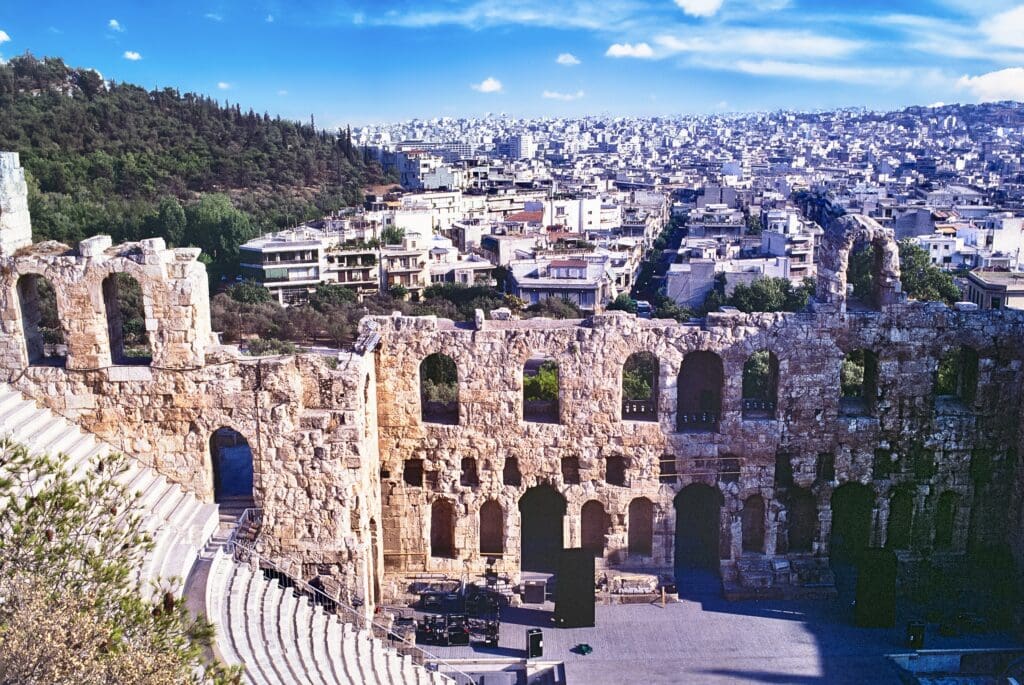
Greece’s priceless crown jewel is the Acropolis of Athens with the Parthenon, the most visited and most famous of all Greek landmarks.
Unquestionably, the Athenian Acropolis is the ultimate icon of Athens’ Golden Age, the 5th century BC. Understandably, the Acropolis is Greece’s first UNESCO World Heritage Centre.
Following your essential must-visit to this one-of-a-kind archaeological site, discover at its base a lesser-known landmark: the Greco-Roman Odeon of Herodes Atticus.
Dating from the 2nd century AD, the marble outdoor ampitheatre climbs dramatically on the southwest slope of the Acropolis.
Abandoned since the 3rd century AD, the Herodion’s ancient ruins were restored for opera star Maria Callas to perform at the 1957 Athens Festival.
Since La Divina’s landmark performance, the greatest stars of classical music, pop and rock, dance, and theater continue to grace the Odeon’s stage.
Tips to Visit the Odeon of Herodes Atticus
The best way and, in fact, the only way to go inside the Odeon of Herod Atticus requires a ticket to a performance.
With the spectacular stage, excellent acoustics, and stunning views, any event at the Herodion is certain to be unforgettable.
The performance season traditionally opens in May and runs through September, weather permitting. Because of the extraordinary setting, tickets typically sell out.
Plan to see a concert or show under the summer night sky at Athens Epidaurus Festival.
At all other times, the Herodion can be seen from atop the Acropolis or at street level along Dionysiou Areopagitou Street.
Check out the best tours of the Acropolis and adjacent landmarks.
Roman Agora of Athens and Tower of the Winds
The Roman Agora of Athens stands between the bustling shops, restaurants, and coffee houses in Athens’ historic neighborhoods, Plaka and Monastiraki.
Not to be confused with the much older 6th century BC Ancient Agora of Athens, this Roman archeological site dates from the 1st century BC.
Roman Emperors Julius Caesar and Augustus Caesar bequeathed money to build this agora, including a unique octagonal building: the Tower of the Winds.
The octagonal Tower of the Winds or Horologion is believed to be the world’s oldest weather station. Ancient sundials still tell time today.
The elegant marble exterior features sundials, which still tell time today. Each of the eight sides depicts one of the eight Anemoi, the Greek gods of winds.
The interior is one large open room with holes in the floor for the water clock. Water would have flowed from the nearby Roman Aqueduct.
Other meteorological functions likely included an astronomical clock, as well as a weather vane on the roof which is roughly 26 feet (8 m) tall.
Tips to Visit the Roman Agora and Tower of the Winds
The Roman Agora of Athens opens daily in season from April 1 to October 31; on the first Sunday of the month from November to March. Weather permitting, of course.
Admission to the Roman Forum includes outside access to the Tower of the Winds.
Tickets are available on-site at the Gate of Athena Archegetis, goddess of Colonies.
Online tickets are available from Hellenic Heritage, the official government agency.
For greater insight and understanding of Athens’ vast history spanning millenia, a guided tour with a professional local guide is a great idea.
Picturesque Plaka and Monastiraki are also charming, colorful, and wonderful neighborhoods to wander.
Explore the best tours of Plaka and Monastiraki.
Greek Landmarks Off the Beaten Path in Central Macedonia
Early Christian and Byzantine Monuments, Thessaloniki
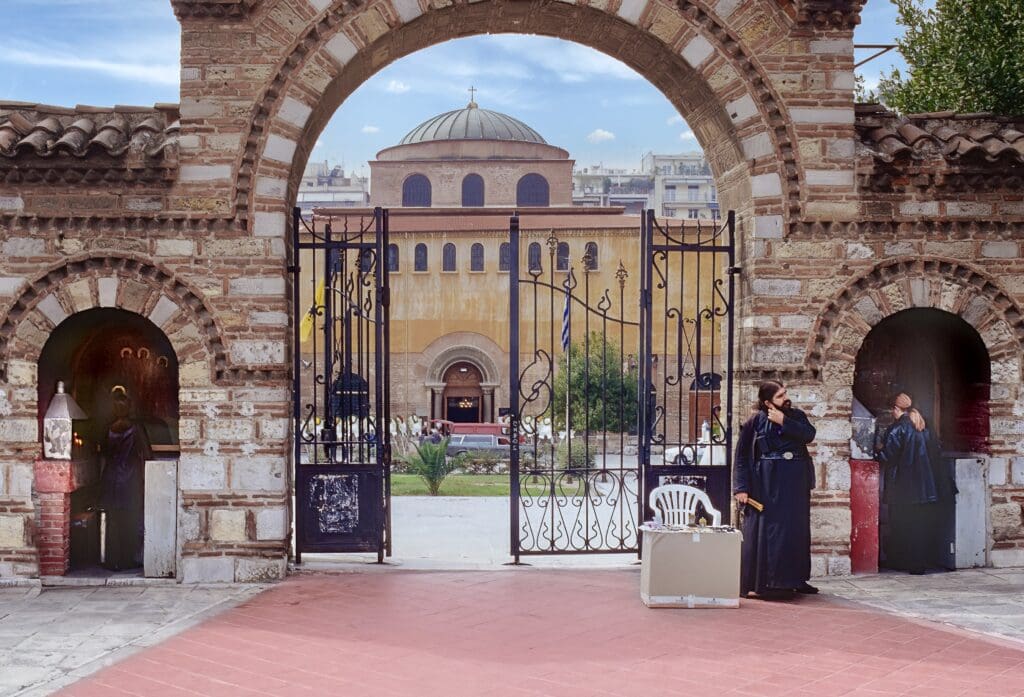
Since its founding in 315 BC, through the Roman, Byzantine, and Ottoman empires to modern Greece, Thessaloniki (also known as Saloniki, Thessalonica, and Salonica) has always been a major metropolis.
Saint Paul the Apostle preached here. He also wrote two letters to the faithful, the Bible books of First and Second Thessalonians.
Thessaloniki’s magnificent Paleochristian and Byzantine monuments comprise a UNESCO World Heritage Centre.
These 15 landmark churches, monasteries, and Byzantine baths date from the 4th century AD to the 13th and 14th centuries.
UNESCO states the “mosaics of Thessalonika’s monuments (such as the Rotunda, Saint Demetrius and Hosios David [Latomou Monastery]) are among the great masterpieces of Early Christian art.”
Tips to Visit the PaleoChristian and Byzantine Monuments of Thessaloniki
The Museum of Byzantine Culture is a great place to start exploring this co-capital of ancient Byzantium.
The best way to dress for Orthodox churches and monasteries is modestly. All visitors should expect to cover their shoulders, arms, and legs.
So in addition to cash for the admission fees, the best things to bring are light shawls, long skirts, or pants to slip on and take off easily in warm summer months.
OTE Tower, Thessaloniki
OTE Tower is the tallest building and among the newest landmarks in Thessaloniki.
Opened in 1966, the OTE Tower soars 249 feet (76 m) with panoramic views over the city. Even more, the tower rotates 360 degrees every hour.
For an eye-opening observatory experience, consider a special OTE experience that includes entry, a reserved table, and light bites in the top-floor dining room.
Because Thessaloniki is an important city from ancient times until today, leading the way in arts, industry, and gastronomy, an introductory guided tour is a great idea.
Discover the best tour options and experiences.
Greek Landmarks Off the Beaten Path in Crete
Among thousands of Greek Islands, Crete not only is the largest island but also has the largest population. So large, in fact, the island, plus a few small islands and islets, comprise an entire Region of Greece.
Shaped like a long spearhead, Crete divides the South Aegean Sea and the Libyan Sea. Pristine coastline, beautiful beaches, and above all, rugged mountains denote its topography.
Ever since the advanced Bronze Age Minoan civilization in evidence at Crete’s most famous landmark Knossos Palace, the Region of Crete has always had its own distinctive culture, traditions, and nature.
Asterousia Mountains
Crete’s mountain ranges include a popular landmark of nature: the Samaria Gorge, a UNESCO World Biosphere Reserve.
However, Crete has another less famous but equally important landmark of nature: the Asterousia Mountains.
Protected by the EU Natura 2000 Network, Asterousia is also a UNESCO World Biosphere Reserve.
Surprisingly, Greece has only one more UNESCO World Biosphere Reserve, Mount Olympus on mainland Greece.
The Asterousia range is Europe’s southernmost mountain range. The terrain is diverse: From coastal reefs, submerged sea caves, sea cliffs, and palm groves to rocky slopes, gorges, waterfalls, and forests.
Abundant different species of flora and fauna, including up to 200 different bird species, thrive here.
Small traditional villages, monasteries, and archaeological sites dot the mountains. As do ancient caves in use by hermits and others from ancient times until today.
In short, Asterousia is among the best places to explore and enjoy outdoor adventures off the beaten path.
Tips to Visit Asterousia Mountains
Whether you want a scenic nature hike, an adventuresome trek, or a high-adrenaline paragliding experience, the opportunity is here.
Trails and paths abound for easy to expert-level mountain biking, hiking, and climbing.
Speaking of which, serious canyoneering enthusiasts will thrill to find seven via ferrata routes; as well as challenging gorges requiring specialized expertise, equipment, and access.
Greek Landmarks Off the Beaten Path in Eastern Macedonia and Thrace
The Region of Eastern Macedonia and Thrace (EMT) is in northeastern mainland Greece and shares a border with Bulgaria and Türkiye.
Since antiquity, this traditional and rural region is deeply rooted in agriculture and viticulture. EMT produces its own brandy called Tsipouro, a Greek Protected Designation of Origin (PDO) spirit.
However, sericulture (silk) sets EMT apart from all other regions in Greece.
Evros, Alexandropouli, and especially Soufli were, and still remain, major pins on the UNWTO Western Silk Road Map.
Soufli
United Nations World Tourism Organization (UNWTO) launched the Best Tourism Villages program in 2021 to recognize “villages that are leading the way in nurturing rural areas and preserving landscapes, cultural diversity, local values, and culinary traditions.”
Greece’s inaugural winner, Soufli, is, at the time of this publication, the only Greek village in the UNWTO Best Tourism Villages.
Still, Soufli remains a hidden gem landmark.
Soufli is notable for an array of crafts and trades: For instance, cart making, winemaking, beekeeping, and above all, silk farming and silk making.
Several museums present the silk spectrum from start to finish, that is, from mulberry trees to silkworm cocoons to silk thread, fabric, and fashions. Two of the most prominent include:
Firstly, the Silk Museum of the Piraeus Bank Group Cultural Foundation. Secondly, the Art of Silk Museum of the Tsiakiris Silk House, Greece’s largest silk manufacturer since 1954.
Both of these museums are in 19th century neoclassical landmarks: the Silk Museum in the Kourtidis mansion and cocoon house; and the Art of Silk Museum in an ancestral mansion of the Tsiakiris family.
Tips to Visit Soufli
Flights between Athens International Airport “Eleftherios Venizelos” (ATH) and the Region of Eastern Macedonia and Thrace (EMT) serve two airports:
The primary airport is Dimokritos International Airport “Democritus” (AXD) in Alexandropoulis, EMT’s largest city. Secondarily, Kavala International Airport “Megas Alexandros” (KVA) in Kavala.
Upon arriving in the Region of Eastern Macedonia and Thrace (EMT), the best way and also the fastest way to visit Soufli is by car. This area specifically lends itself to an independent road trip.
The driving distance between Dimokritos International Airport and Soufli is approximately 36 miles (59 km).
Other transportation options include KTEL public buses running from Athens to EMT’s regional capital, Komotini, which has no airport, to Alexandropouli, and other EMT towns such as Kavala, Xanthi, and Drama.
KTEL inter-city buses and long-distance taxis, of course, also serve Soufli.
As EMT’s largest city, Alexandropoulis provides the most tourism infrastructure. However, for an authentic experience in Balkan village life, stay in Soufli.
Historic and homey Hotel Koukouli extends traditional hospitality and old-fashioned accommodations in a 19th-century architectural landmark.
Previously a cocoon house, the renovated stone three-story property is now a year-round family-run hotel, simple and quaint. Unlike some quaint village inns, every guest room has a private bathroom.
Check the best rates for your stay.
Greek Landmarks Off the Beaten Path in Epirus
Zagorochoria, Zagori
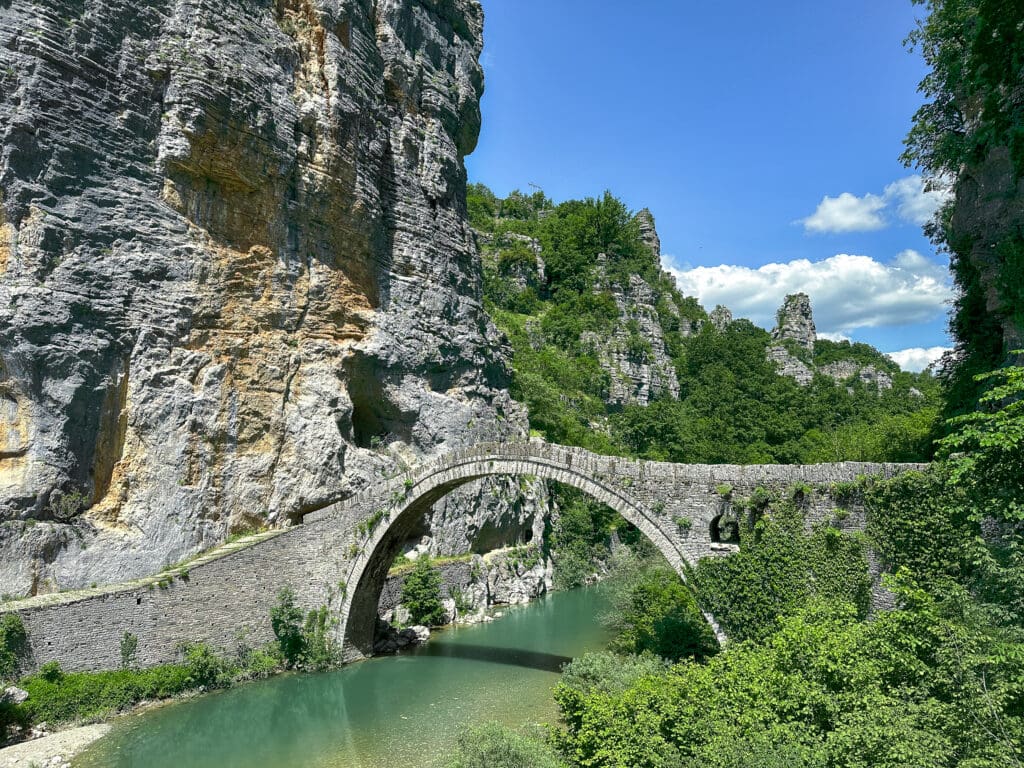
Zagori encompasses the geographical wonders of Northern Pindos National Park, with its world-famous natural landmark, Vikos Gorge.
Additionally, Zagori includes man-made monuments to mountain life: the 46 traditional villages of Zagorochoria.
In September 2023, Zagorochoria received official recognition as a UNESCO World Heritage Centre.
The Zagori Cultural Landscape honors the unique network of small stone villages tucked into the mountains and forests.
Remote and rugged, these rustic stone villages connect via arched stone bridges, rugged stone paths, and steep stone stairs. Local master masons crafted this stonework during the 17th, 18th, and 19th centuries.
Some villages are now accessible via roads; others have no road access. The higher one goes in Zagorochoria, the fewer visitors one sees.
UNESCO notes the tradition, authenticity, and integrity inherent in these remarkable villages.
As Spotlight Sojourns’ family heritage comes directly from Epirus, this photographer and this writer wholeheartedly agree with UNESCO.
Greek Landmarks Off the Beaten Path in the Islands
Lefkada, Ionian Islands
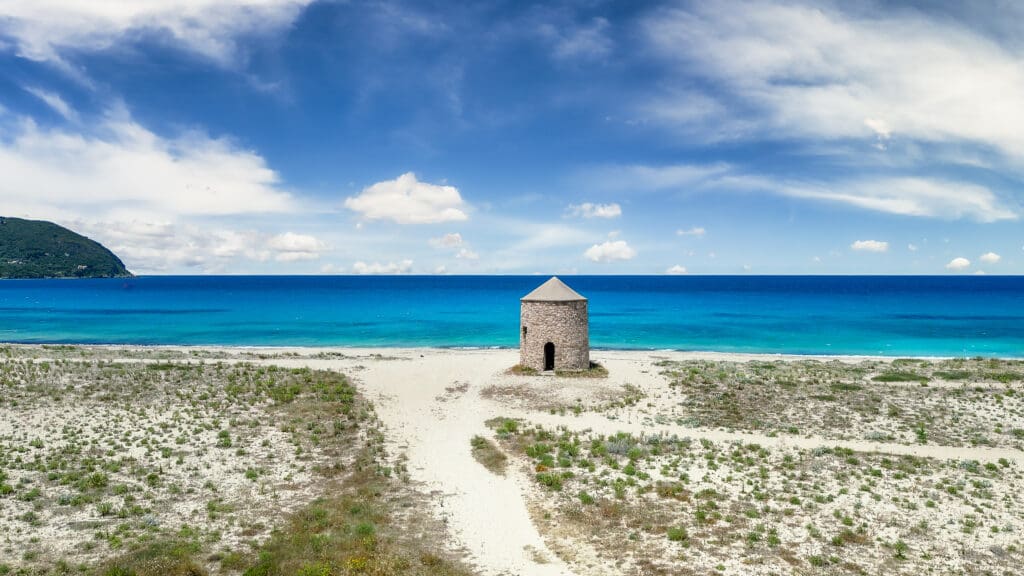
Just as legends connect ancient Ithaca to modern Lefkada, a narrow causeway and short bridge connect this Ionian island to mainland Greece.
Historians study Lefkada’s epic tales of goddess Aphrodite, Homer’s great adventurer Odysseus, tragic poet Sappho, and Britain’s first king Brutus of Troy. As well as Romans, Ottomans, Venetians, French, and others over centuries.
Lefkada abounds with medieval heritage and historical sites, such as in Lefkada Town. The medieval Castle of Santa Maura (Kastro) and moat make an impressive entrance to the island’s capital city.
Outside Lefkada Town on the western side, a long expanse of beach from Lefkada-Gyra to Agios Giannis has derelict windmills reminiscent of Mykonos windmills.
Greek Landmarks Off the Beaten Path in Peloponnese
Mycenae
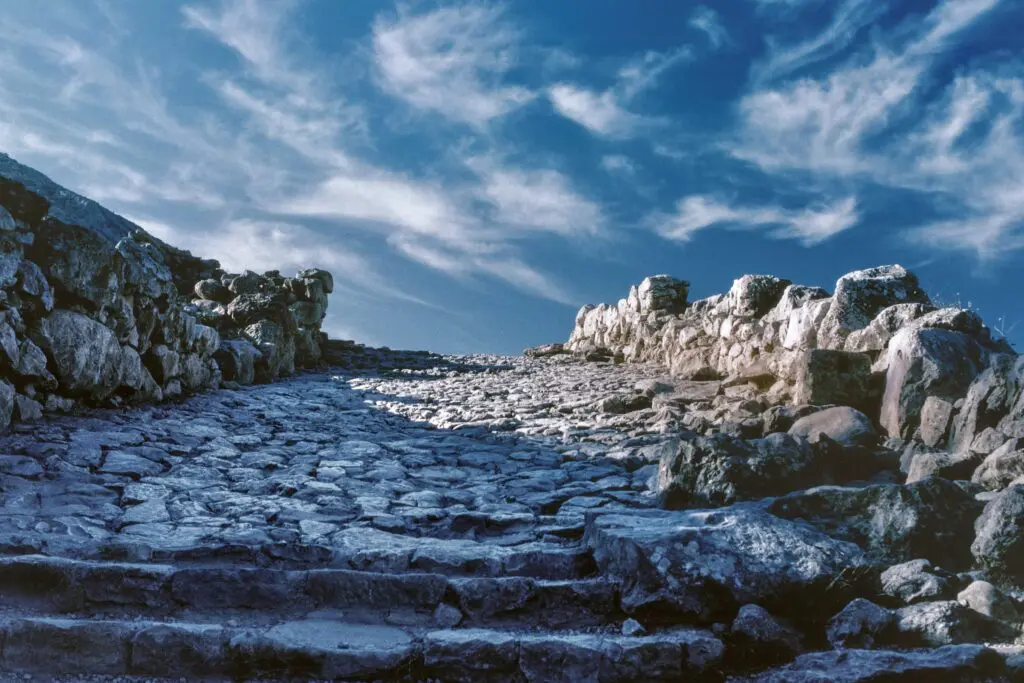
Inspiring imaginations for millenia, the Mycenean civilization makes its ultimate statement in ancient Argolis.
The Bronze Age landmarks Mycenae and Tiryns together are a UNESCO World Heritage Centre.
These ancient citadels, mighty cities, and epic stories continue to captivate scholars, travelers, artists, and dreamers of all kinds.
Just as the names of Mycenean heroes and kings echo through aeons; for instance: Perseus, Agamemnon, and Orestes,
In the same way, do the names of architectural landmarks resound; for example: the Lion Gate, Treasury of Atreus, tholos Tomb of Clytemnestra, and “mighty walled Tiryns” of which Homer spoke in The Iliad.
Following after Crete’s Minoan civilization, the Mycenean civilization flourished from approximately 17th century BC before it fell in the late 12th to early 11th century BC.
Subsequently, Mycenae and Tiryns were abandoned, then re-settled, and eventually abandoned again for centuries.
Nevertheless, their status as tourist attractions of irresistible allure continued.
Writing his Description of Greece in the 2nd century AD, geographer and travel writer Pausanias visits Mycenae, at this point in ruins.
He narrates its Homeric connections, mythological history, and splendid sights, including the Lion Gate and Tholos tombs.
Pausanias also attributes the massive stone walls to the mythical Cyclops. Because only giants had the size and strength to lift and place these gargantuan stones, up to 36 feet (11 m) thick at Tiryns.
More than a thousand years after Pausanias’ sojourns, the tourism pace increased markedly.
Because in 1841, renowned Greek archaeologist Kyriakos Pittakis of the Archaeological Society of Athens, first excavated the Lion Gate and began work on the Tomb of Clytemnestra.
Then in 1874, amateur German archaeologist Heinrich Schleimann came to Mycenae. Working alongside the Greek Ephor of Antiquities Panagiotis Stamakis, Schleimann excavated the site. At length, they discovered Grave Circle A with a gold death mask.
Consequently, the gold Mask of Agamemnon, so named by Schleimann, is now in Athens at the National Archaeological Museum.
Sanctuary of Asklepios, Epidaurus
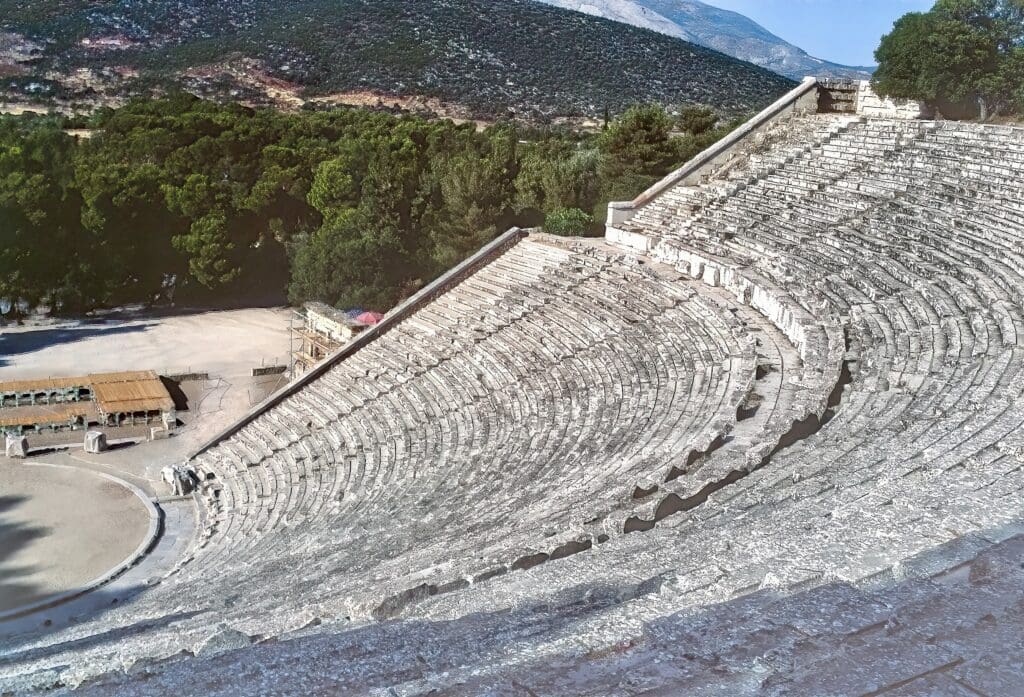
Question: What do you think when you hear “Epidaurus?” Frequent Answer: “Ancient theatre.”
Well, the ancient Theatre of Epidaurus is unquestionably spectacular. Indeed, Pausanias gave rave reviews in his Description of Greece.
In the 4th century BC, sculptor and architect Polykleitos the Younger designed the theater in harmony with nature.
The Romans later expanded the theater to seat 13,000 to 14,000 guests in the audience. The acoustics are as close to perfect as possible.
But this beautiful theatre is only one of many monumental landmarks in the Sanctuary of Asklepios, a UNESCO World Heritage Centre.
Dedicated to Asklepios (Asclepius), the Greek god of medicine, the Sanctuary became the role model for all others in the Greco-Roman world.
Within the sacred complex are ruins of the Temple of Asklepios, the Temple of Artemis, the elegant circular Tholos Polykleitou, the Stadium, and more.
Tips to Visit Mycenae and Epidaurus
For a standard starting point, the driving distance between Athens International Airport “Eleftherios Venizelos” (ATH) and Mycenae is about 96 miles (150 km).
The driving distance between Mycenae and Epidarus is approximately 30 miles (48 km).
Two equally important archaeological sites in close proximity offer full-day immersion in antiquity.
See the different guided tour options.
The best things to bring are bottled water, a hat, sunglasses, and sunscreen. Some paths are uneven, whereas other paths are paved, so comfortable shoes are always a good idea.
Better yet, make your home base in enchanting Nafplio.
Award-winning boutique Hotel Athena Nafplio offers a central location in Nafplio’s historic heart.
The heritage hotel has comfortable guest rooms with premier Coco-Mat sustainable bedding and updated bathrooms. Balconies in most rooms overlook either Syntagma Square, Venetian fortresses Palmidi, or Akronafplia.
Check the best rates for your stay.
Birthplace of the Caryatids, Karyes
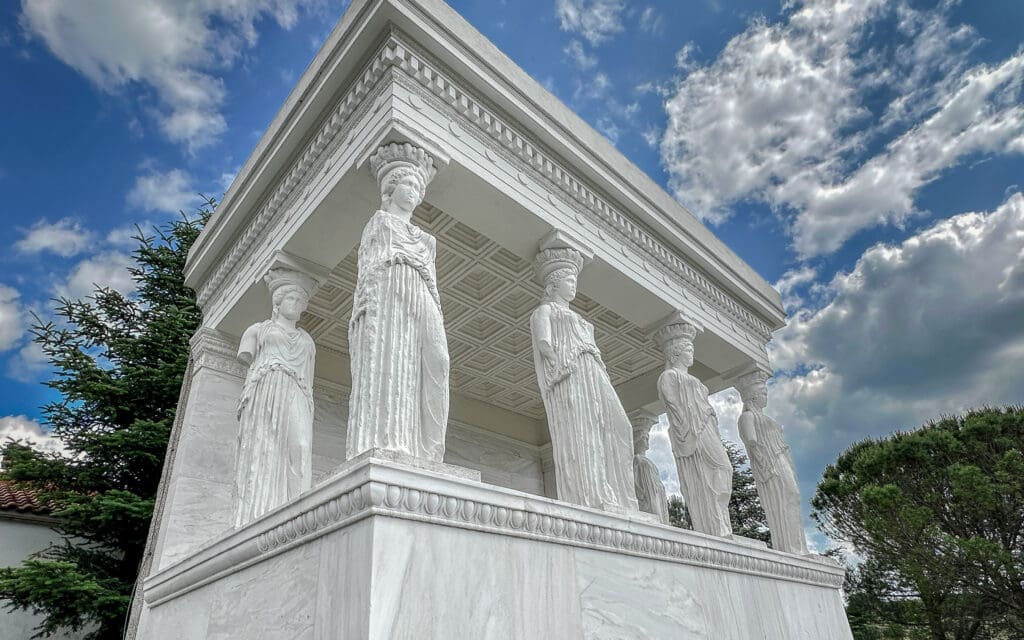
Of all the famous ancient monuments on the Athenian Acropolis, the favorite monument for this writer and this photographer is the Erechthion’s southern Porch of the Caryatids.
In architectural terms, a Caryatid is a female figure that provides support instead of a column. Similarly, a male figure that supports is called an Atlas.
However, Caryatides are more than architectural figures. They are dancing maidens whose birthplace is Karyes, an ancient village still inhabited today in the Peloponnese mountains.
Karyes in the Peloponnese region is occasionally confused with Karyes in the Mount Athos region, which is Greece’s Holy Mountain and open only to male visitors.
When visiting Karyes in the 2nd century AD, Pausanias describes the maidens’ dance to honor the goddess Artemis.
Centuries later, in the 20th century AD, villagers of Karyes commissioned an exact marble replica of the ancient temple porch.
Just as the gracious Caryatides patiently presided on the Acropolis of Athens since the 4th century BC,
So too, do the six sisters serenely serve on the little Acropolis of Karyes since 1983.
Greek Landmarks Off the Beaten Path in Thessaly
Early Christian and Byzantine Church, Kalampaka

Perched on towering rock pillars, the medieval monasteries of Meteora draw all eyes. Likewise, the Meteora monasteries draw all cameras.
The James Bond 1981 film For Your Eyes Only was shot on location here. The dramatic rock formations also inspired The Eyrie in Game of Thrones.
But just below the “big rocks” is a little church worthy of attention in the ancient yet modern city of Kalampaka.
Ancient, because Kalampaka has existed under various names for thousands of years. Modern, because the city was destroyed in 1943 and later re-constructed anew.
Circa 4th to 5th century AD, the Church of the Dormition of Virgin Mary is the oldest monument in the Meteora area. Centuries of candle smoke darken the frescoes, just as bullets of strife pockmarked the marble.
What makes this church so special is its marble pulpit in the central nave. It’s the world’s only surviving Early Christian pulpit in the round.
Despite its age and a big modern church nearby, this ancient landmark is in active service and is the preferred church for weddings and baptisms.
Tips to Visit Kalampaka
The cobblestone streets, lively restaurants, and café scene in Kalampaka are well worth overnight stays. Overnight stays also offer the possibility to see stunning sunsets and sunrises over Meteora.
Opened in 2022, The Storyteller Boutique House is an elegant family-run hotel in the heart of town. Five serene guest rooms incorporate different literary or cinematic themes. An elevator and step-free access help everyone. Curated high-quality amenities, as well as a superb breakfast, complete this tranquil haven.
Check the best rates for your stay.
Greek Landmarks Off the Beaten Path in Western Macedonia
Byzantine Kastoria
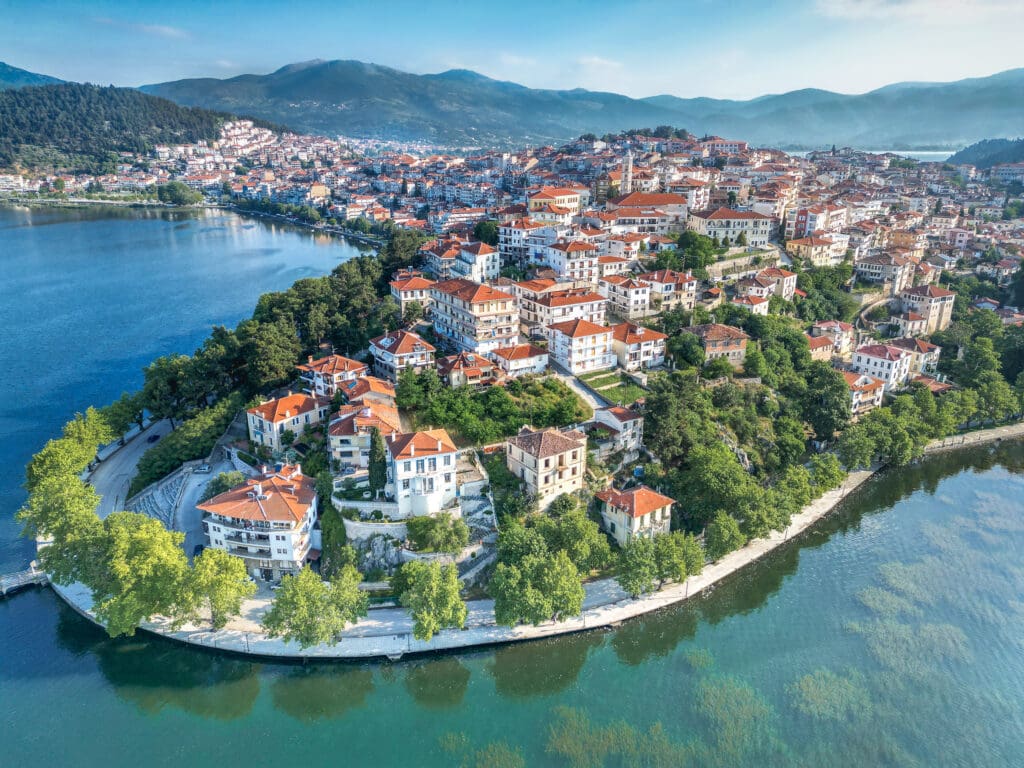
Since Eastern Roman Emperor Justinian I founded Byzantine Kastoria in the 6th century AD, power, wealth, and culture have flourished in this lakeside city through different influences, empires, and epochs.
A hidden gem in the Balkans, Kastoria is on Lake Orestiada. part of the EU Natura 2000 network and a Greek National Monument of Natural Beauty.
Swans, geese, and many other birds, some rare and endangered, complete the peaceful scene.
From the Citadel and Acropolis of Kastoria down to the Doltso and Apozari neighborhoods, Old Town Kastoria showcases the best of Byzantine and post-Byzantine life through the 19th century.
Atop the Acropolis of Kastoria, the Byzantine Museum of Kastoria arranges free guided walking tours to some of the many Byzantine and post-Byzantine church landmarks.
Such as the Church of Panagia Koumpelidiki, circa 9th to 11th century. This tiny church with a small dome is the city’s symbol and hopeful emblem.
A long lakefront promenade connects the enchanting Old Town with the energetic New Town.
Tips to Visit Kastoria
The popular time to visit Kastoria is in winter when snow falls on Mount Visti and ice frosts Lake Orestiades.
In the cold months, Kastoria transforms into a chic après-ski resort for the alpine crowd.
But in the warm months, especially spring and fall, Kastoria settles into a slower pace.
The stone landmark Hotel Doltso, formerly the family’s manor house, blends an ideal location with history, hospitality, and luxury.
Ten tastefully designed modern rooms, all with private bath and individual air-conditioning/heating controls, overlook a charming garden. It’s a great place to stay, only steps away from two main attractions: the waterfront and Old Town’s heart, Plateia Doltso.
Check the best rates for your stay.
Greek Landmarks Off the Beaten Path in Conclusion
Greece understandably ranks among the Top ten most visited countries in the world, and Athens is among the Top ten most visited cities in the world.
Because Greece’s remarkably rich history, iconic monuments, spectacular scenery, and beautiful beaches captivate imaginations through the ages.
Nonetheless, there’s more to see than world-famous landmarks and popular attractions.
So, congratulations on choosing to visit Greece, both on and off the beaten path.
Get ready to explore, experience, and be inspired by her glories of the ancient present and vibrant past.
Greek Landmarks Off the Beaten Path Map
•••
Check Out More Recommendations
READ: Famous Landmarks in Greece: Beautiful Historical Places to Visit
READ: Vienna in Winter: Best Things to Do During a Magical Season
ALSO READ: Christmas in Lisbon: Best Things to Do in the Festive Season
•••
FAQs
What is a good walkable Greek city?
Athens, Greece’s capital city and most populated city, is a wonderful walkable city. Especially in its historic areas as neighborhoods, for instance: Syntagma Square, Plaka, Monastiraki, Psiri, and Thissio.
Major attractions and historical landmarks tend to be close together, either a short walk or a quick Metro ride away.
When you turn off main avenues and busy streets, then you will find Athens off the beaten path. Elegant architecture, charming shops and cafes, quaint churches, and quiet corners await.
How do I get around Greece off the beaten path without a car?
Although a rental car is an easy and efficient way to explore off the beaten path in Greece, you can certainly travel almost everywhere, near or far, without a car.
Here are two best ways to get around Greece off the beaten path without a car:
Firstly, public bus:
Greece has a nationwide public transportation system on the mainland and on the Greek Islands (that is, its roughly 300 inhabited islands).
KTEL, the public bus network, and local buses are the best choice for extensive and inexpensive transportation.
Long-distance, regional, intercity, and local routes connect cities, towns, villages, and just about everywhere.
However, remote places may have bus service only once or twice a week. So do like the Greeks do: check bus schedules online and at the station.
Secondly, guided tours with tour transportation:
Professional local tour guides deliver expert insight but also deepen your understanding of places, traditions, and people.
The best tour guides further share insider anecdotes and tell stories, which make history, culture, and community come alive.
Most guided tours also provide round-trip transportation, a real benefit when certain Greek landmarks are very far off the beaten path.
Having a professional driver at the wheel can help you relax and enjoy the experience more fully.
What is the best time to visit Greece?
In order to answer this FAQ, let’s first clarify the three tourism seasons:
Tourism peak season is the high season, the summer months. Shoulder season, the in-between season, is springtime and the fall. The low season is the winter months.
In Greece, peak season runs from mid-June until mid-September.
Spring shoulder season starts April 1, when cruise ships first set sail, until mid-June. Fall shoulder season runs from mid-September until October 31.
The low season goes from November 1 until March 31.
Now that the seasons are clarified, here’s our opinion on the best time to visit:
After traveling to Greece numerous times over many years, this writer and this photographer (who is himself Greek) consider our ideal time to visit is May and early October.
Even though the sea is still cool, the weather is usually ideal – not too hot, not too cold. Many places and services are indeed open, although not everything everywhere is open. The pace, people, and prices are more relaxed and easy than in peak season.
What are the best things to bring to Greece?
Because Greece is such a popular tourist destination, and tourism overall is booming, it’s indeed likely that Greek landmarks off the beaten path will be busier than ever before.
So, all things considered, the best things to bring are: Patience, flexibility, and, oh yes, gratitude to visit Greece.
•••
GET: Now that you’ve heard Greece’s story of slightly less famous but absolutely fabulous landmarks off the beaten path, get your exclusive free guide to tell your own story easily.
•••
All opinions expressed are Spotlight Sojourns’ own.
When you book or make purchases through some links, Spotlight Sojourns may earn a small commission at no extra cost to you. Thank you for using our affiliate links which support original writing and original photography for you.
